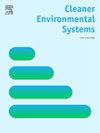碳捕获和利用生命周期评估的方法回顾-模型是否反映了目的?
IF 4.9
Q2 ENGINEERING, ENVIRONMENTAL
引用次数: 0
摘要
二氧化碳捕获和利用(CCU)被认为是一种减缓气候变化的战略,生命周期评估(LCA)通常用于评估其脱碳潜力。在此背景下,本研究通过回顾106项CCU系统的LCA研究及其方法,调查CCU系统LCA研究的可理解性。结果显示LCA研究的多样性。他们研究了一系列CCU产品,这些产品由不同来源的二氧化碳制成,具有不同的工业范围。大多数研究将所调查的CCU过程与传统生产系统或产品的气候变化影响进行了比较。在106篇文章中,无论捕获碳的来源或产品中二氧化碳的储存时间如何,47篇报告减少了,27篇声称产生了负面影响。被审查的研究中有一半没有报告LCA的目标,而那些有目标的研究很少解释评估的目的。这使得研究的方法选择和结果难以理解。为了更容易理解CCU系统的LCA研究,建模需要反映评估的目的。这包括考虑时间方面的碳被研究的CCU系统和产品保留的时间和时间。此外,在LCA研究报告和指导方针方面都需要改进,特别是在目标报告以及目标定义阶段如何与LCA研究中的方法决策相关联方面。本文章由计算机程序翻译,如有差异,请以英文原文为准。

Methodological review of life cycle assessments of carbon capture and utilisation – Does modelling reflect purposes?
Carbon dioxide capture and utilisation (CCU) is considered a climate change mitigation strategy and life cycle assessment (LCA) is often used to assess its decarbonisation potential. The current study investigates the understandability of the LCA studies of CCU systems in this context by reviewing 106 LCA studies of CCU systems on their methodologies. The results show a diversity in LCA studies performed. They studied a range of CCU products created from varying sources of carbon dioxide and had different industrial scopes. The majority of studies compare the climate change impact of the investigated CCU process to the conventional production systems or products. Of the 106 articles, 47 report a reduced and 27 claim a negative impact regardless of the source of captured carbon or the storage time of the CO in the product. Half of the reviewed studies did not report the goal with the LCA, and those who stated a goal seldom explained the purpose of the assessment. This made the methodological choices and results of the studies difficult to understand. For more understandable LCA studies of CCU systems, the modelling needs to reflect the purposes of the assessments. This includes considering the time aspects of when and for how long carbon is retained by the studied CCU systems and products. Furthermore, there is a need for improvement in both the reporting of LCA studies and the guidelines, especially regarding the reporting of the goal and how the goal definition phase is connected to the methodological decisions in the LCA study.
求助全文
通过发布文献求助,成功后即可免费获取论文全文。
去求助
来源期刊

Cleaner Environmental Systems
Environmental Science-Environmental Science (miscellaneous)
CiteScore
7.80
自引率
0.00%
发文量
32
审稿时长
52 days
 求助内容:
求助内容: 应助结果提醒方式:
应助结果提醒方式:


